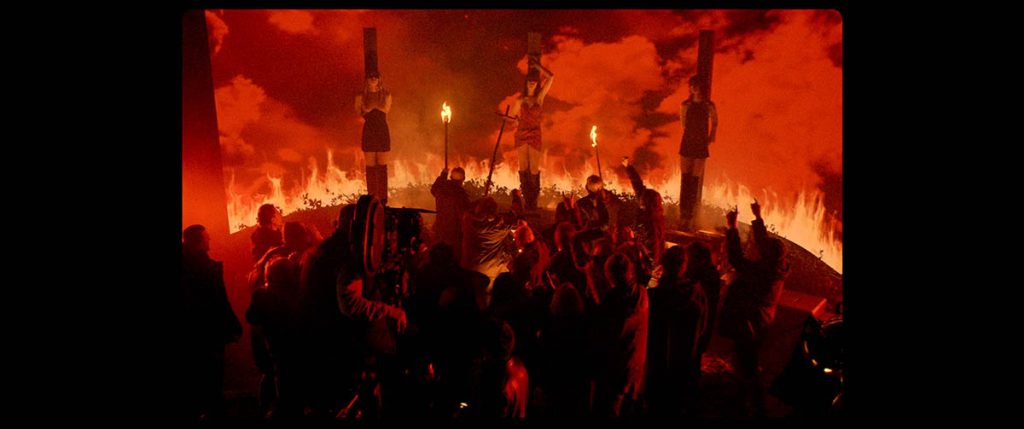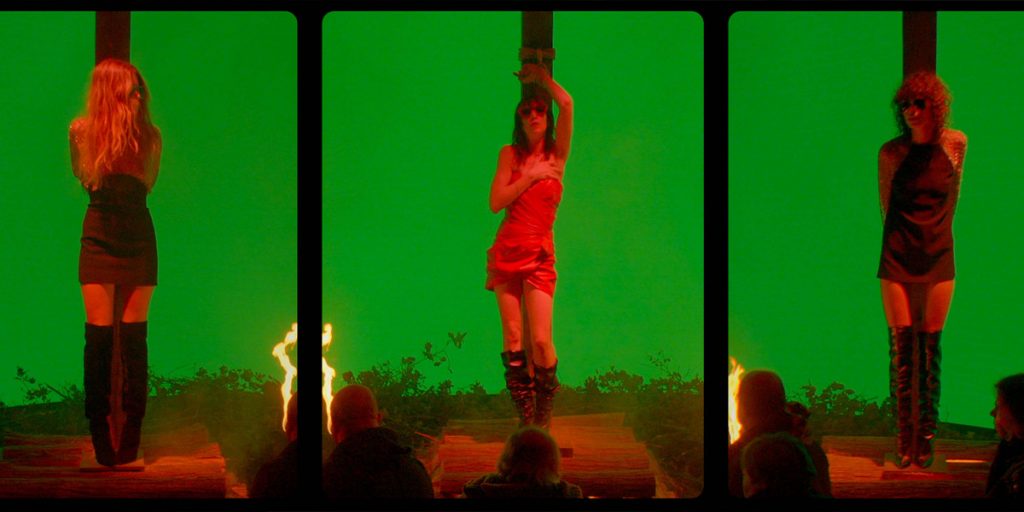Although it may seem like a gimmick at times, for the most part Gaspar Noé’s Lux Æterna engages and entrances with its split-screen techniques and bad-acid trip neon stylistic tendencies.
One of this generation’s well-known cinematic provocateurs, Gaspar Noé has always found a myriad of ways to trigger the audience. Every one of his features has its extensive and goading scenes that stay in the viewer’s minds – especially the Cannes Film Festival audience, since he always has his premieres there – for quite a long time, for better or worse. Having said that, I think we have reached the point where he can’t cause such a high reaction as his features did back in the day due to knowing what we are in for.
However, for the most part, he’s delivering state-altering sequences with his usual directorial techniques, like the strobing lights or peculiar lighting, the lingering tracking shots, among others. Recently, he has been experimenting with different methods or forms to shoot his movies. A technique he’s been utilizing more and more is the split-screen, which can be seen fully-fledged in his works Vortex and his commercial/short, Summer of ‘21. This method causes the viewer to be more immersed in the movie as you follow different characters simultaneously, even though it could be a double-edged sword.
Three years after its Cannes premiere, Lux Æterna at long last finds its way to theaters and uses all these previously mentioned techniques. Lux Æterna was supposed to be a quick fifteen-minute or less promotional short for fashion company Yves Saint Laurent; however, in pure Noé fashion, he couldn’t contain himself.
So instead, he ended with a fifty-one-minute-long nightmarish film (or mockumentary) about witches, chaos amidst a film set, and sexism in the industry. It begins with a gently flickering strobe light of red, blue, and green shades and a quote from novelist Fyodor Dostoevsky that serves more as a warning for what’s to come stylistically. It then transitions into a countdown from the number seven, later to show a video collage of witch persecutions, including scenes from classic pictures, Häxan and Day of Wrath. After that, it switches to a conversation between actresses Béatrice Dalle and Charlotte Gainsbourg, who play themselves in this meta-referential work, about sexocide and witches, intertwining it with the film industry of today and the afterlife.

The actresses waste time talking with each other until it is time to start the shoot for God’s Craft, a tale about witchcraft in a modern age. Although the conversation is interesting and engaging since it feels natural and off the cuff, the split-screen dynamic in that segment feels like a gimmick instead of a storytelling vehicle. In this particular moment, it feels like such because they are near one another and conversing together.
Similar things like this happen throughout its fifty-one-minute runtime, hurting the viewing experience. There are occasions in which it follows the actresses through different rooms and corridors (alluding once again to Andrzej Żuławski’s Possession), interacting and doing their respective jobs, or at least trying to, because everything goes wrong immediately on that film set. People scream, most of the crew doesn’t know what is going on, there are plans of backstabbing the director and firing Béatrice, actresses (Abby Lee and Mica Argañaraz) have mental breakdowns, wannabe filmmakers pitch projects, and to top it all off, technical issues arise.
This is where the split-screen technique works best. When the chaos keeps growing and growing, you get more immersed in it. During this havoc, Noé critiques the harassment and inappropriate behavior toward women in the film industry of today. He highlights several challenges that they face when working with male producers, directors, journalists, and other crew members who are suffocating and pestering them to a great extent.
Nevertheless, there are occasions where its screenplay can seem a bit silly or pretentious to a harsher point. It’s a bit of a paradox since some of its “deep” conversations are just placeholders for what Gaspar wants to say. It doesn’t get to the eye-rolling point of his 2015 feature, Love, where he had a character named Gaspar and another one called Noé, which was coincidentally played by himself. Albeit I wish he stepped back from doing such antics when he has his audience engaged in what he’s providing. Now, what’s equally engaging and almost unwatchable are the film’s last twelve minutes.
We have seen Gaspar use strobe lights a lot in the past (Animal Collective’s music video for “Applesauce”, Enter the Void, the ending of Irreversible, etc), but in Lux Æterna, he goes overboard. This rampant visual experience may disorient you, in both good and bad ways, and in the same breath, cause you to pass out if you can’t handle it. If you think I’m exaggerating, paramedics were waiting outside the door during the premiere just in case the worst happened. Even the end credits use strobe lights, so you can’t escape Lux Æterna until it literally fades to black.
This won’t appeal to everyone’s taste; it is a hard film to get into. It’s transcendent, and Noé keeps breaking cinematic conventions to create new experiences. At times it may feel like a molotov cocktail of acid and other drugs, which may give you a massive headache. Yet, there’s something enticing amongst the disorderly behavior. This isn’t close to being his best work, but I trust him to keep delivering features with interesting concepts that may stir the pot of theatrical provocations.
Lux Æterna is now available to watch on digital and on demand.

